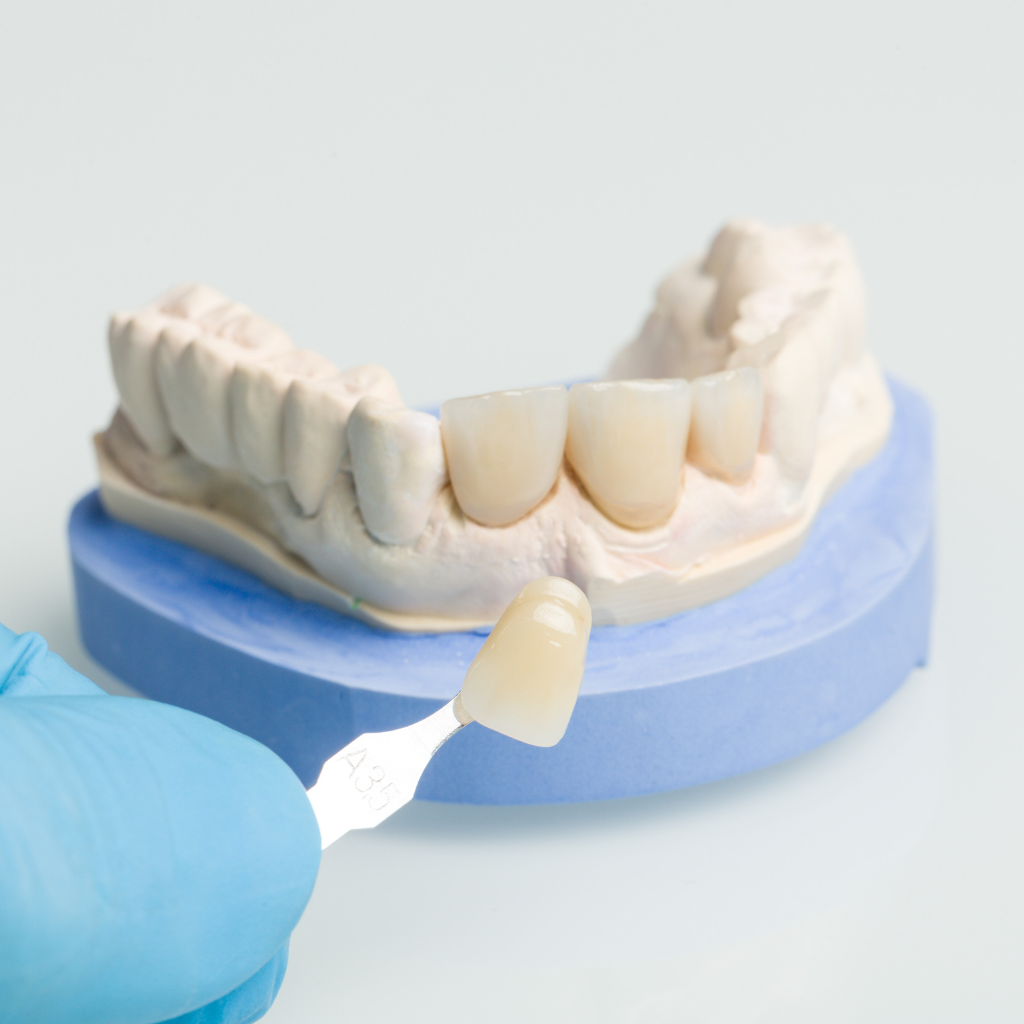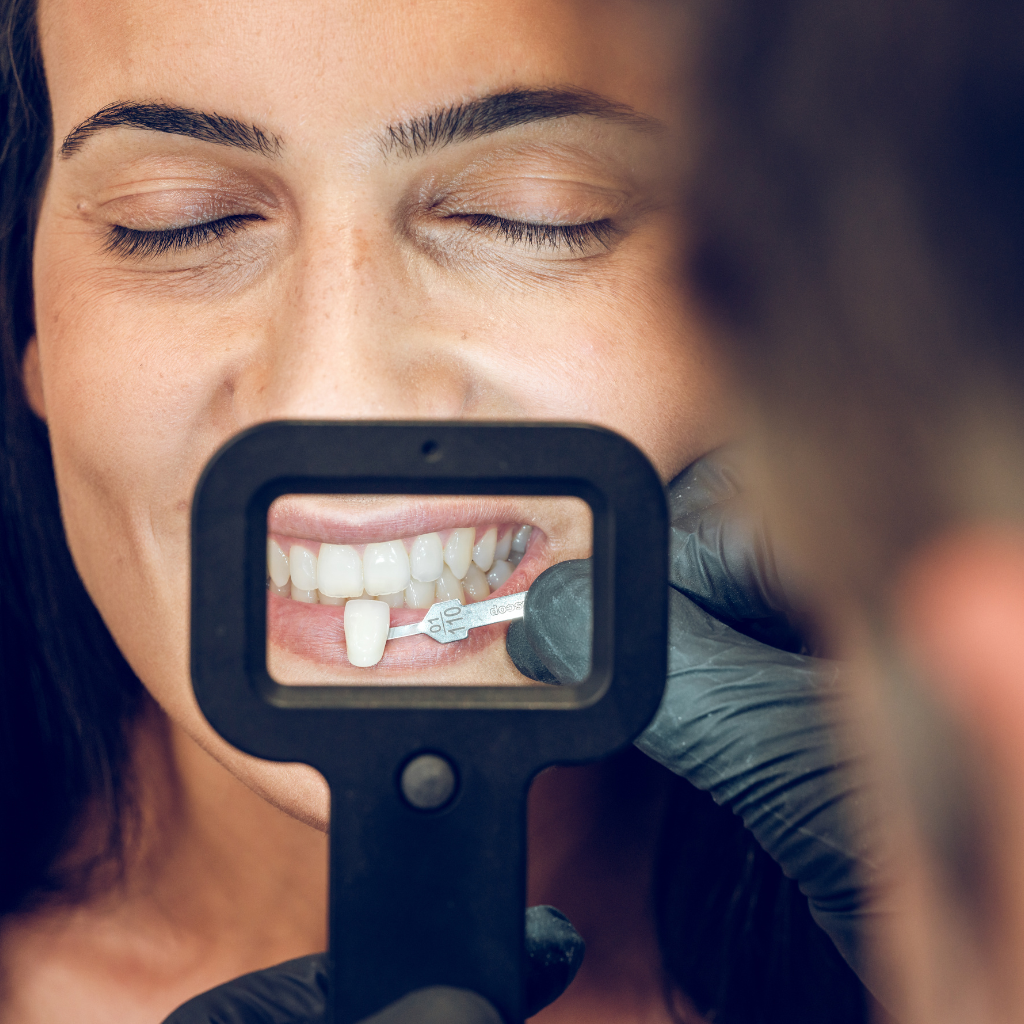Dental crowns and veneers improve teeth aesthetics and function but differ greatly in application and structure. Crowns cover the entire tooth and are ideal for restoring teeth that are greatly damaged or decayed, offering strength and protection. Conversely, veneers are thin coverings attached only to the front surface of teeth, suitable for cosmetic enhancements such as correcting chips or discoloration. Understanding these distinctions can guide individuals in selecting the best option for a healthier, brighter smile.
Key Takeaways
- Dental crowns encase the entire tooth and are ideal for restoring severely damaged teeth, while veneers cover only the front surface for cosmetic improvement.
- Crowns are more invasive, requiring significant tooth reshaping; veneers are less invasive, preserving more of the natural tooth structure.
- Crowns offer functional restoration and protection against further decay; veneers primarily enhance the aesthetic appearance and correct minor flaws.
- Insurance often covers crowns as restorative treatments, whereas veneers are usually considered cosmetic and may not be covered.
- Crowns generally have a higher initial cost but require consideration for potential replacements, whereas veneers typically have lower long-term maintenance costs.
What is a Crown, and When is it Used?
A dental crown, also referred to as a crowned tooth, is a custom-fitted cap that encases the entire surface of a tooth, typically made from materials like porcelain, ceramic, or metal.
It is mainly used to restore the function and appearance of teeth that are markedly damaged or decayed.
When deciding between a crown and a veneer, evaluating the extent of tooth damage and the desired aesthetic outcome is essential, as crowns provide more thorough coverage and strength than veneers.
Understanding a Crown
While a crown may appear to be a simple dental fixture, it is, in fact, a custom-made restoration used to cover a tooth that is damaged or decayed.
Dental crowns are essential in repairing weakened teeth, offering strength and aesthetics. The dental crown procedure involves preparing the entire tooth structure, guaranteeing the crown fits seamlessly.
Once prepared, a dental crown covers the entire visible part of the tooth, adhering to dental cement. This process not only restores the functionality of a damaged tooth but also prevents further decay.
Placing a permanent crown is a critical step, meticulously executed to guarantee the longevity and comfort of the dental restoration. Crown placement effectively returns a damaged tooth to its best function and appearance.
Benefits of a Crown for Damaged Teeth
Understanding the scope of a dental crown’s application reveals its significant benefits for damaged teeth. Crowns generally encapsulate the entire tooth, providing a robust solution for damaged or weakened teeth that might otherwise require extraction.
The benefits of dental crowns are extensive, particularly in restoring both the function and aesthetic of the tooth. Crown materials, such as porcelain and ceramic crowns, are favored in cosmetic dentistry for their natural appearance and durability.
Unlike veneers, which only cover the front surface of the teeth, crowns protect and reinforce the entire tooth structure. This makes them an indispensable option in dental treatment, ensuring longevity and stability for teeth compromised by decay, breakage, or severe wear.
Choosing Between a Crown or Veneer
Understanding the difference between crown and veneer is essential in making an informed decision.
Crowns are often recommended for worn teeth that require significant structural restoration. They cover the entire tooth surface, providing strength and protection.
Conversely, veneers are thin layers designed primarily for cosmetic improvement, particularly on the front teeth. They cover only the tooth’s front surface and are less invasive than crowns.
When choosing between veneers and crowns, consider the extent of tooth damage and the desired cosmetic outcome. Crowns offer more extensive coverage and support, while veneers provide a quick aesthetic fix to superficial flaws on the tooth surface.
What is a Veneer, and How Does it Work?
A dental veneer refers to a thin shell of porcelain that is custom-fitted and bonded to the front of a tooth to enhance its appearance.
These veneers are particularly beneficial for front teeth, offering a cosmetic solution for discoloration, chips, or gaps.
Veneers are ideal for patients seeking a durable yet aesthetically pleasing correction without more invasive procedures.

Exploring Porcelain Veneers
Porcelain veneers often serve as a favored solution for enhancing dental aesthetics and function. These veneers are thin layers of porcelain or composite resin customized to fit the front surface of teeth, primarily used in cosmetic procedures. Porcelain veneers are favored for their durability and natural light-reflecting qualities. They differ from crowns in that veneers cover only the front and sometimes the top of the tooth, whereas crowns encase the entire tooth.
| Feature | Porcelain Veneers | Composite Veneers |
|---|---|---|
| Material | Porcelain | Composite Resin |
| Durability | High | Moderate |
| Aesthetic Match | Excellent | Good |
| Procedure Complexity | More complex | Less complex |
These distinctions are essential in the veneers vs crowns debate, especially when considering veneers for front teeth.
Benefits of Veneers for Front Teeth
While enhancing the aesthetic appeal of one’s smile, veneers, particularly for front teeth, offer several benefits beyond mere cosmetic improvement.
Veneers are ideal for minor shape correction, providing a very thin layer of porcelain fused directly to the front of the tooth. This application addresses issues like discoloration and chips and subtly alters tooth size and alignment for a more uniform look.
Unlike porcelain crowns, which cover the entire tooth, veneers bond to the surface of your teeth, targeting primarily cosmetic purposes.
With proper care, the durability of veneers complements their aesthetic benefits, ensuring a long-lasting, bright smile without extensive dental interventions, thereby preserving more of the natural tooth structure.
When Veneers Are Ideal
Veneers are highly favoured in situations where cosmetic enhancement is desired, but the structural integrity of the teeth is largely intact.
Unlike crowns, veneers require less tooth surface removal, preserving more of the natural tooth. For those weighing the choice between dental crowns and veneers, evaluating that veneers and crowns are similar in enhancing dental appearance is pivotal. Yet, the cost of porcelain veneers can be more favourable depending on the case.
Veneers are primarily used for cosmetic dental treatments and are ideal for correcting discoloration, minor misalignments, or gaps.
Getting veneers involves a less invasive procedure, making them the right choice for patients seeking significant aesthetic improvements without extensive dental work.
Crowns vs Veneers: What’s the Difference?
Understanding the distinctions between crowns and veneers is key to making an informed dental restoration choice.
Crowns encase the entire tooth and are commonly used for teeth that are greatly damaged, while veneers are thin covers placed over the front of the teeth to enhance aesthetics.
Each option has specific pros and cons, impacts the natural tooth structure differently, and suits various dental conditions and patient needs.

Pros and Cons of Each Option
When considering dental restoration options, weighing the pros and cons of crowns and veneers is essential, as both serve distinct purposes and offer different benefits and drawbacks.
Crowns are used to fully cover a damaged tooth, enhancing its strength and appearance. They are ideal when a tooth’s structural integrity is compromised. Dental crowns can last many years with good oral hygiene and regular dental check-ups. However, they require more tooth preparation, which can be more invasive.
Veneers, on the other hand, are primarily used for cosmetic improvements, requiring less tooth alteration. They are effective for addressing discoloration and minor misalignments. Yet, veneers might not be suitable for teeth that require extensive restoration.
Choosing between dental crowns and veneers depends largely on individual dental health needs.
How to Decide: Veneer or Crown
Deciding between a dental crown and a veneer depends largely on your teeth’ specific needs and condition.
- Tooth Reduction: Crowns require more extensive tooth reduction compared to veneers. This involves reshaping the entire tooth to the gum margin to fit a crown, whereas veneers often need minimal front surface preparation.
- Prepared Tooth Stability: A prepared tooth for a crown might be preferable if it has significant damage or decay, providing stability and strength.
- Longevity and Protection: A permanent veneer is less intrusive than a crown but might not offer the same level of protection against future decay or damage.
Crowns envelop the entire tooth, ensuring enhanced durability.
Impact on Natural Teeth and Tooth Structure
Although crowns and veneers are designed to improve dental aesthetics and function, their impact on natural teeth varies considerably due to their structural differences. Crowns typically encase the entire visible portion of a tooth, which requires significant reshaping and removal of tooth enamel. This makes them suitable for more severely compromised teeth or teeth with a large filling. Veneers, however, are thin coverings that adhere to the front part of the tooth, requiring less removal of the existing tooth structure and preserving more of the natural tooth.
| Aspect | Crowns | Veneers |
|---|---|---|
| Coverage | Entire tooth | Front surface only |
| Tooth Preparation | Extensive (more tooth removed) | Minimal (less tooth removed) |
| Ideal for | Severely worn or damaged teeth | Cosmetically displeasing teeth |
How Do Crowns and Veneers Affect Dental Health?
Crowns and veneers greatly impact dental health, necessitating routine professional evaluations to maintain integrity and function.
Long-term care of dental crowns involves specific hygiene practices to prevent decay at the margin where the crown meets the natural tooth.
Meanwhile, veneers require meticulous cleaning and occasional polishing to preserve their aesthetic qualities and prevent discolouration.
The Role of Regular Dental Check-Ups
Regular dental check-ups, as detailed in our dental veneers faq, play an essential role in maintaining the health and longevity of both crowns and veneers.
These visits allow dentists to evaluate and ascertain the integrity of dental work, including the fit and function of dental crowns and veneers.
Here are three key aspects addressed during these check-ups:
- Inspection of Material Integrity: Dentists assess how crowns are made and their current condition, checking for any chips, cracks, or wear that might compromise the dental structure.
- Gum and Bone Health Evaluation: Regular reviews help monitor the impact of dental bridges or crowns on surrounding tissues, preventing potential gum diseases or bone loss.
- Adjustment and Cleaning: Proper care for your dental restorations includes professional cleaning and necessary adjustments to avoid complications like root canal treatment due to decay under restoration.

Long-Term Care for Dental Crowns
Many patients receive dental crowns and veneers to improve the aesthetics and functionality of their teeth, but understanding the long-term care requirements for these restorations is essential for maintaining oral health.
Dental crowns, especially those made from metal alloys, demand diligent maintenance to prevent potential complications. Unlike a temporary crown, which is just a placeholder, a permanent crown is ready to handle daily stresses, provided it receives the right dental treatment.
Regular cleanings and check-ups are vital as they help monitor the crown’s integrity and the surrounding tissue’s health. Patients should be aware that differences between dental crowns can influence their durability.
Typically, metal crowns are more suitable for back teeth due to their strength and long-term resilience.
Maintaining the Appearance of Your Teeth with Veneers
While dental crowns focus on restoring strength and functionality, dental veneers primarily enhance the visual aspect of teeth.
Veneers, typically made from stain-resistant composite resin or porcelain, are thin layers designed to cover the front surface of teeth. They are about half a millimetre thick and are carefully bonded to the original teeth, aligning with the gum line for a natural appearance.
Key points in maintaining the appearance of veneers include:
- Routine Cleaning: Regular brushing and flossing are essential as veneers flush with the gum line, preventing dental concerns like plaque buildup.
- Avoiding Stains: Opt for a diet that minimizes exposure to stain-inducing substances such as coffee, red wine, and tobacco.
- Regular Dental Check-ups: Professional cleanings and inspections guarantee veneers maintain their aesthetic appeal and address any underlying issues promptly.
What Should You Know About the Dental Procedures?
Understanding the procedures for obtaining dental crowns and veneers is essential for informed decision-making.
Applying porcelain crowns entails a multi-step process that includes tooth preparation, impression taking, and the placement of both temporary and permanent crowns.
Similarly, installing veneers involves careful tooth preparation followed by the precise bonding of the veneer to the tooth surface.
The Process of Getting a Porcelain Crown
Opting for a porcelain crown begins with a thorough evaluation by a dental professional, who assesses the patient’s oral health and the specific needs of their teeth. This initial step determines if a dental crown might be necessary, often due to broken teeth or following dental implant surgery.
The process of getting a dental crown involves several key steps:
- Preparation: The tooth is reshaped to guarantee a proper fit for the crown. This might involve removing parts of the damaged tooth or building it up if necessary.
- Impression Taking: An impression of the prepared tooth is made to create an exact model for the crown.
- Crown Fabrication and Fitting: The custom crown is crafted from porcelain, precisely fitted, and bonded to the tooth.
Understanding how much your crown or veneer is going to cost and whether dental insurance covers it can alleviate financial concerns.
Steps Involved in Veneers Application
After discussing the intricacies of obtaining a porcelain crown, it is equally important to explore another popular dental restoration option: veneers. The application of veneers involves several precise steps tailored to enhance the appearance of decayed or weak teeth, often without a root canal procedure. However, this can vary depending on the tooth’s condition.
| Step | Description | Note |
|---|---|---|
| Diagnosis & Planning | Examination to determine the suitability for veneers. | Varies by dental condition |
| Tooth Preparation | Slight reshaping of the tooth surface. | Minimal enamel removal |
| Impressions | Creating a mold for the exact fit of the veneer. | Precision is vital |
| Temporary Veneer | Applying a temporary veneer if needed. | Not always necessary |
| Bonding & Final Touches | Permanently attaching the veneer and making adjustments. | Aim for a natural look |
This table outlines the essential steps in veneer application, highlighting the process’s tailored nature to individual dental needs.
Understanding Temporary Crown and Permanent Crown
While temporary and permanent crowns serve as protective coverings for damaged teeth, they differ considerably in purpose, materials, and duration of use.
- Purpose: Temporary crowns are used to protect the tooth and maintain dental alignment while the permanent crown is being fabricated, which can take a few weeks.
- Materials: Temporary crowns are typically made from acrylic-based materials or stainless steel, offering less durability.
- Duration of Use: Temporary crowns are worn for a short period, usually until the permanent crown is ready for placement, whereas permanent crowns are designed to last for many years with proper care.
Does Dental Insurance Cover Crowns and Veneers?
Coverage of dental crowns and veneers by insurance varies greatly, depending on the policy specifics and whether the procedure is deemed medically necessary or purely cosmetic.
Comparatively, the costs of dental crowns and veneers can differ, with factors like material choice—ranging from composite resins for veneers to metallic alloys for crowns—playing a vital role.
Understanding these distinctions is essential for patients considering these treatments to make informed financial decisions.
Insurance Coverage for Dental Treatments
Dental insurance policies vary widely, but they typically cover procedures categorized under either restorative or cosmetic dentistry, influencing the extent of coverage for crowns and veneers.
Here are key aspects:
- Restorative Coverage: Crowns are often covered because they are necessary for restoring tooth function. Coverage usually ranges from 50% to 80%, depending on the plan specifics.
- Cosmetic Exclusions: Veneers are frequently classified as cosmetic and may not be covered by standard dental insurance policies.
- Annual Limits: Both treatments are subject to annual coverage caps, which can affect the out-of-pocket cost for patients, especially if multiple procedures are needed within a year.
Cost Considerations of Dental Crowns VS Veneers
When considering the cost of dental crowns versus veneers, assessing the initial expenses and the long-term financial implications is essential. Choosing these two dental procedures often hinges on various factors, including material cost, longevity, and insurance coverage.
| Factor | Dental Crowns | Veneers |
|---|---|---|
| Initial Cost | Generally higher | Varies |
| Longevity | 10-15 years | 7-15 years |
| Maintenance Cost | Periodic replacement | Minimal |
| Insurance Coverage | Often covered | Sometimes covered |
| Aesthetic Outcome | Excellent | Superior |
Insurance typically covers crowns if deemed medically necessary, whereas veneer coverage can be more restrictive and often considered cosmetic. Consequently, patients are advised to check with their insurance provider to understand the coverage details.
Comparing Composite Veneers and Metal Crowns
In the domain of dental restoration, the choice between composite veneers and metal crowns involves a detailed comparison of their durability, aesthetics, and overall cost-effectiveness.
- Durability: Metal crowns typically offer superior durability compared to composite veneers. They are able to withstand substantial bite forces, making them suitable for back teeth, whereas composite veneers may wear down or chip more easily.
- Aesthetics: Composite veneers provide a more natural appearance as they can closely match the existing tooth colour. Metal crowns, though durable, lack the translucency of natural teeth and can sometimes be visible at the gum line.
- Cost-effectiveness: Composite veneers are initially less expensive than metal crowns.
However, metal crowns may be more economical, considering longevity and potential replacement costs.
Conclusion
In summary, dental crowns and veneers enhance dental aesthetics and functionality. While crowns encase the entire tooth, offering structural restoration, veneers provide a cosmetic solution by covering only the front surface of the teeth. Choosing between the two depends on individual dental conditions, desired outcomes, and financial considerations. Patients must consult with dental professionals to understand each option’s implications, benefits, and costs, including potential insurance coverage.


